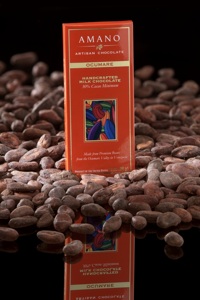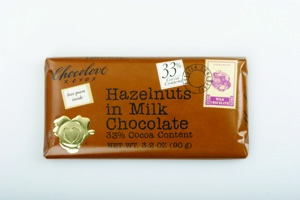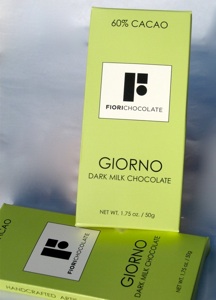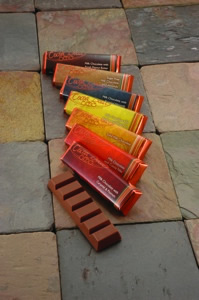Special Feature: Products Sally Recommends
milk chocolate lovers, unite!
Too long pushed aside, scoffed at, or regarded as being just for babies and those with bland palates, milk chocolate is at last achieving some recognition among the cognoscenti and tastemakers in this world. It’s about time! I’ve loved milk chocolate since I was a very young child, and now, too many years later, I still adore it. Dark chocolate in its many forms is wonderful, and there are some instances and occasions when nothing but bittersweet will do. But I don’t need all of my flavors to be intense constantly. Sometimes, I just want something a little lighter in character, antioxidants be damned. (As I’ve mentioned before in this column, chocolate should be eaten for pure pleasure, as any health benefits, questionable to begin with, tend to require the ingestion of large quantities. Get over the guilt, and eat small amounts of the good stuff!)
Do you know how milk chocolate is made? Many people assume that milk or cream is added to dark chocolate to create milk chocolate, but that’s not really accurate. The production of all real chocolate begins with the harvest of cacao beans, followed by fermentation and drying. The still-raw beans are thoroughly cleaned, then roasted, cooled, and cracked open. The cacao nibs are then ground to form chocolate liquor, and the liquor is heated and compressed to remove much of the fat, resulting in cocoa powder and cocoa butter. All of that should sound familiar. To make milk chocolate, manufacturers combine precise amounts of cocoa powder, cocoa butter, sugar, milk powder, and vanilla (and/or other flavorings). The milk powder is sometimes slightly caramelized; some manufacturers use condensed milk from which the water is driven out. The ingredients are mixed at a set temperature before the conching step (there are a few manufacturers who omit conching, but not many). After conching, the chocolate is tempered and molded into bars. (For more about the chocolate manufacturing process, I recommend a look inside Christian Teubner’s The Chocolate Bible.)
As is the case with any chocolate, you need to select carefully. Cheaply-made, poor quality milk chocolates are everywhere. Brands once reviled for such milk chocolate are now trying to improve their images. Their labels are fancier, with correspondingly increased prices, and their higher cacao percentages are prominently displayed on those labels. Alas for all the window dressing, as most of these chocolates remain “mules in horse harness”, to quote a character in Gone with the Wind. They might be polished up and pretty, but they’re not worth their calories.
How, then, does one find a good milk chocolate? Some will disagree, but I say you need to look beyond the usual grocery store brands. Legally, milk chocolate is required to contain a paltry 10% cacao content (cocoa solids), but that will make for a very weak chocolate flavor. Look for brands with cacao content percentages beyond the 20’s. Remember, though, that the percentage indicates only the relative quantity of cocoa solids; it’s never an indication of product quality. Check the ingredient list, and try to find a brand that uses real vanilla, as opposed to vanillin. Vanillin is a cheaper substitute for vanilla, and I think it simply doesn’t taste as good. Some manufacturers now omit vanilla from their chocolate altogether; whether or not that’s acceptable depends upon your own taste preferences. A good milk chocolate bar will contain no fats other than cocoa butter. Finally, let your taste buds be your guide. Celebrity Chef X might ramble on for hours about the merits of a particular milk chocolate, but if you don’t care for the way it tastes, it’s not a good product for you. It’s important to keep tasting new milk chocolates, too; you never know when one you consider truly great might come along.
As a change of pace, why not have a milk chocolate bar tasting party? Limit the number of brands you try to no more than half a dozen. Use your favorite milk chocolate brands, or experiment with some new to you. Remember to keep portion sizes reasonable and have plenty of beverages to go around (anything from water to champagne will do, but remember that strongly-flavored drinks can overwhelm the milk chocolate); you’ll also need palate cleansers between samples (saltines, sorbet---whatever you wish). Start with the bar lowest in cacao content, and work your way up.
Do you prefer your chocolate bars with add-ins, or on the fancier side? If you do, there are plenty of chocolatiers out there catering to your tastes. And, while we’ve been discussing only milk chocolate bars here, please don’t feel you have to limit yourself to those. Increasingly, milk chocolate is now finding its way into good-quality sauces, desserts, cookies, pastries, and confections.
If you’ve restricted your consumption of Theobroma cacao to solely dark chocolate for some time now, do your taste buds a favor and try some of the newer milk chocolates now available. You’ll be pleasantly surprised. And don’t forget that chocolate always makes a fine gift; how about a selection of a few carefully-chosen, great-quality milk chocolate bars for that chocolate elitist friend of yours?
Recipe of the Month:
Milk Chocolate Mousse
This is a very rich dessert, best served in small portions after a light meal. It has a light chocolate color, as well as the delicate flavor of milk chocolate. Conveniently, it must be made ahead of time and will sit quite happily in the fridge for a few days (tightly covered, please); it also freezes nicely (defrost, still in wrappings, in the fridge). I serve this in small white porcelain ramekins that hold about 1/3 cup each, although you could also spoon it into small, decorative, stemmed glasses. To decorate, keep it simple: just before serving, sprinkle a small amount of grated or shaved milk chocolate on top of each portion (alternatively, you can garnish each portion with a few milk chocolate curls).
Supermarket chocolate will not do for this mousse (unless your market carries some very good chocolate!). What you use depends on your preferences, as always, but the chocolate must be very high quality or there’s no point in making this. If you like the taste of alcohol in your mousse, omit the vanilla and substitute an equal amount of a liqueur with a flavor compatible with milk chocolate (an orange or coffee liqueur would work well). Another tip: don’t overbeat the cream once you’ve added the chocolate mixture. If you do, the mousse will be stiff or may have a curdled appearance.
7 ounces best-quality milk chocolate, very finely chopped
1 ounce best-quality semisweet chocolate, very finely chopped
Few grains of salt
3 Tablespoons very hot water
1 Tablespoon vanilla
1 cup heavy cream
Chill medium bowl and beater(s) for a handheld mixer for at least twenty minutes.
In medium microwaveable bowl, combine finely chopped chocolates and salt. Microwave at 50% (medium) power for one minute; stir thoroughly. Continue microwaving at 50% (medium) power for further short intervals, stirring very well after each, until chocolate is almost melted. Continue stirring until chocolate is melted and smooth. All at once, add hot water. Stir in well until blended and smooth (when you first add the hot water, chocolate will seize and clump; keep stirring it in, scraping bottom and sides of bowl with rubber spatula. Chocolate should smooth out as you keep stirring. If you simply cannot get it smooth, process at high speed in workbowl of food processor fitted with steel blade just until smooth.) Set chocolate mixture aside to cool to room temperature (if chocolate is at all warm when added to the whipped cream, the cream will deflate).
In chilled bowl with chilled beater(s), beat cream at high speed just until you can see traces of beater marks in the cream. All at once, add cooled chocolate mixture. Continue beating at high speed just until mousse holds a soft peak (chocolate mixture will probably not be entirely combined with cream at this point, but that’s OK). Working quickly, fold chocolate mixture into cream with a rubber spatula just until mousse is of an even color.
Portion mousse into small ramekins or small stemmed glasses. Chill at least two hours, covering tightly when cold. To serve, garnish each portion with a bit of shaved or grated milk chocolate or a few small milk chocolate curls. Store in refrigerator for up to a few days; freeze for longer storage.
10 to 12 portions
Recommendations of the Month:
Below is a very incomplete list of some manufacturers who produce milk chocolate bars and a few other treats) worth trying. Frankly, there are so many making milk chocolate products now that I couldn’t list them all, but you can use these companies as a starting point in your milk chocolate taste explorations.
 Amano Artisan Chocolate, www.amanochocolate.com. Art Pollard is a man obsessed with making bean-to-bar chocolate. In fact, he offers only bars (and roasted nibs from the various beans he uses). Amano currently has two milk chocolate bars, Jembrana and Ocumare. They have very different flavor profiles, so it’s worth tasting both to see which you like better (or, as a friend of mine said upon tasting the two, “You mean I can only choose one I like best?”).
Amano Artisan Chocolate, www.amanochocolate.com. Art Pollard is a man obsessed with making bean-to-bar chocolate. In fact, he offers only bars (and roasted nibs from the various beans he uses). Amano currently has two milk chocolate bars, Jembrana and Ocumare. They have very different flavor profiles, so it’s worth tasting both to see which you like better (or, as a friend of mine said upon tasting the two, “You mean I can only choose one I like best?”).
Guittard Chocolate Company, www.guittard.com. Guittard makes a 38% Orinoco Milk Chocolate bar, under their E. Guittard line. But my favorite milk chocolate product from this company has to be their chips. They’re larger than your regular-sized chocolate chips, and I think they taste a lot better than anything similar you’ll find in most grocery stores. These chips contain real vanilla, too---another point in their favor. These chips are not available online at the Guittard site, alas. While they’re easiest to find on the West Coast (in such chains as Albertson’s, Safeway, and Vons), you can also pick them up at Lund’s/Byerly’s, some East Coast Whole Foods Markets, and in a handful of other chains.
Cioccolato La Molina, www.lamolina.it. La Molina is made in Tuscany. There are milk chocolate bars of 33%, 36%, and 39% cacao content, and I think all are very good. The packaging is eye-grabbing and bold. The downside? It can be very difficult to find these products in the US. However, the folks at www.gustiamo.com may have these bars at times; they also offer flavored milk chocolates from La Molina (mint, milk chocolate with hazelnuts, milk chocolate with peanuts), which I haven’t tried.
 Chocolove Premium Chocolate Bars, www.chocolove.com. Do you have a staple luxury food---you know, something that, strictly speaking, you don’t need to survive, but you like it so much you always have it around? Chocolove makes a 33% cocoa content milk chocolate bar that I am never without. It’s smooth, very mellow, and rather caramelly. There’s a romantic poem inside the wrapper of each bar Chocolove makes, but I don’t need any romance other than this chocolate. They also offer 33% milk chocolate bars in both Toffee & Almonds and Hazelnuts varieties. Recently, they’ve begun selling a single-serving size (1.3 ounce) in both their Milk Chocolate and Toffee & Almonds Milk Chocolate flavors.
Chocolove Premium Chocolate Bars, www.chocolove.com. Do you have a staple luxury food---you know, something that, strictly speaking, you don’t need to survive, but you like it so much you always have it around? Chocolove makes a 33% cocoa content milk chocolate bar that I am never without. It’s smooth, very mellow, and rather caramelly. There’s a romantic poem inside the wrapper of each bar Chocolove makes, but I don’t need any romance other than this chocolate. They also offer 33% milk chocolate bars in both Toffee & Almonds and Hazelnuts varieties. Recently, they’ve begun selling a single-serving size (1.3 ounce) in both their Milk Chocolate and Toffee & Almonds Milk Chocolate flavors.
Omanhene Cocoa Bean Company, www.omanhene.com. I’ve been crazy about Omanhene’s Dark Milk Chocolate for years. The bars, which are colorfully wrapped, have a 48% cocoa content. There is an almost mocha flavor to this chocolate, although it has no coffee or coffee flavoring added. The cacao beans for this chocolate are grown, and the chocolate is manufactured in, Ghana, which happens to be where founder Steven Wallace spent time as a high school foreign exchange student. There are clever packaging options here so that the “ingots”, as the bars are called, make great gifts.
 Fiori Chocolatiers, www.fiorichocolatiers.com. The proprietor of Fiori Chocolatier is not afraid of a gamble; his confections are notable for their bold (and sometimes unexpected) flavors. In bars, try his 47% cacao content milk chocolate (under the name “Mattina”), or, for a more robust approach, go for the 60% dark milk chocolate bar, called “Giorno”. The bars have distinctive wrappers that wouldn’t be out of place in a modern art gallery.
Fiori Chocolatiers, www.fiorichocolatiers.com. The proprietor of Fiori Chocolatier is not afraid of a gamble; his confections are notable for their bold (and sometimes unexpected) flavors. In bars, try his 47% cacao content milk chocolate (under the name “Mattina”), or, for a more robust approach, go for the 60% dark milk chocolate bar, called “Giorno”. The bars have distinctive wrappers that wouldn’t be out of place in a modern art gallery.
Woodhouse Chocolate, www.woodhousechocolate.com. Woodhouse Chocolate sells a solid milk chocolate bar, in addition to Almond Toffee, Peanut Croquant, and Hazelnut milk chocolate bars. If you’d like to up the ante, try their Coco Caramel Mac Nut Bar. The milk chocolate edition features a bar of milk chocolate filled with caramel and toasted coconut, topped with macadamia nuts and drizzled with more chocolate. But the “belles of the ball”, as far as I’m concerned, have to be their Butterfly Bars. There are four different Butterfly Bars. The two made from milk chocolate are the White, Blue, and Yellow Butterfly (flavored with curry and coconut), and the Brown, Green, and White Butterfly (containing currants, toasted almonds, and Raz el Hanout, a Middle Eastern Spice). Beautiful!
 Cocoa Dolce Artisan Chocolates, www.cocoadolce.com. Beth Tully and her kitchen crew produce milk chocolate bars in eight varieties, from one with raisins and roasted hazelnuts to a milk chocolate bar with cocoa nibs. She has also created a fancy-looking milk chocolate “tablet”, or Tavalozza, as she calls it, with a mix of fruits and nuts atop. Ms. Tully sells a lovely selection of individual chocolates, as well, some of which are milk-chocolate-based. While I have not tried her bars or Tavalozza, I’ve tried so much that’s good from this little business that it’s hard to believe anything they produce could be sub-par.
Cocoa Dolce Artisan Chocolates, www.cocoadolce.com. Beth Tully and her kitchen crew produce milk chocolate bars in eight varieties, from one with raisins and roasted hazelnuts to a milk chocolate bar with cocoa nibs. She has also created a fancy-looking milk chocolate “tablet”, or Tavalozza, as she calls it, with a mix of fruits and nuts atop. Ms. Tully sells a lovely selection of individual chocolates, as well, some of which are milk-chocolate-based. While I have not tried her bars or Tavalozza, I’ve tried so much that’s good from this little business that it’s hard to believe anything they produce could be sub-par.
![]()
Stephanie (HandOverTheChocolate@comcast.net) has had a strong affinity for chocolate from a very early age. Family members claim that, as a child, she was able to hear chocolate being opened in the kitchen no matter where she was in the house. Stephanie was baking by the time she was 6 and ran a short-lived baking business out of her parents’ kitchen when she was in high school. She has a Master’s Degree in Foods from Virginia Tech but no formal training in cooking or baking. Consequently, she is a home cook, not a chef. Prior to beginning this column, she had written about chocolate for some 8 years.
Note: This information was accurate when it was published. Please be sure to confirm all rates and details directly with the businesses in question before making your plans.



